Detailed Report on Health Service Management in New Zealand: Analysis
VerifiedAdded on 2021/04/17
|22
|5844
|305
Report
AI Summary
This report provides a comprehensive analysis of health service management in New Zealand. It begins with an introduction outlining the current challenges and restructuring efforts within the nation's healthcare system. The report delves into the Treaty of Waitangi, discussing its principles of partnership, participation, and protection and how they underpin the relationship between the government and the Maori population. It then examines New Zealand's national health strategies, analyzing them through the lens of the Treaty's principles. The study further explores the New Zealand healthcare system, focusing on key organizations, consumers, providers, and policymakers. A comparative analysis between the Australian and New Zealand healthcare systems is conducted to identify challenges. Finally, the report identifies a specific health factor posing a significant challenge to the New Zealand health system and includes a PESTLE analysis to provide a strategic framework. The report concludes with a summary of findings and recommendations for future improvements.
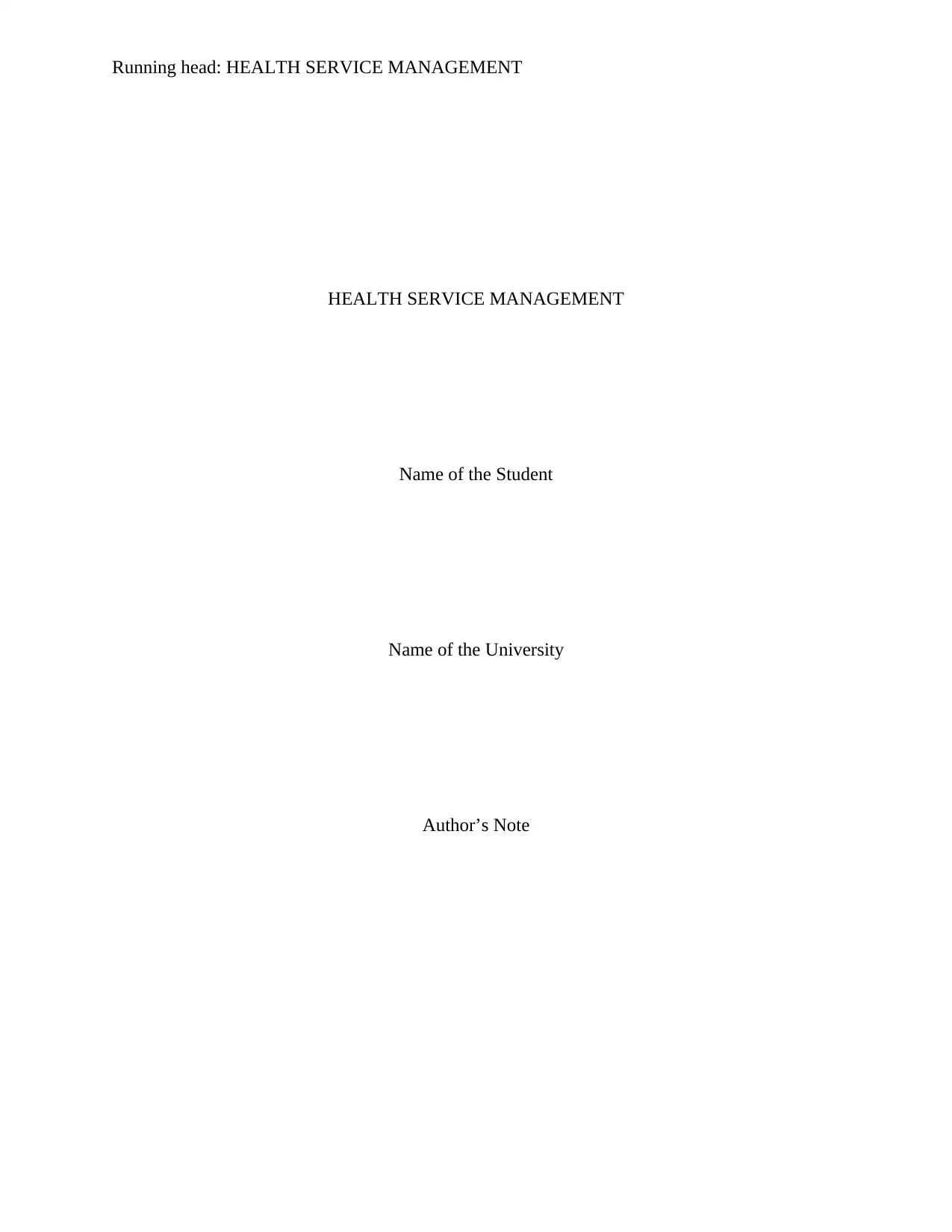
Running head: HEALTH SERVICE MANAGEMENT
HEALTH SERVICE MANAGEMENT
Name of the Student
Name of the University
Author’s Note
HEALTH SERVICE MANAGEMENT
Name of the Student
Name of the University
Author’s Note
Paraphrase This Document
Need a fresh take? Get an instant paraphrase of this document with our AI Paraphraser
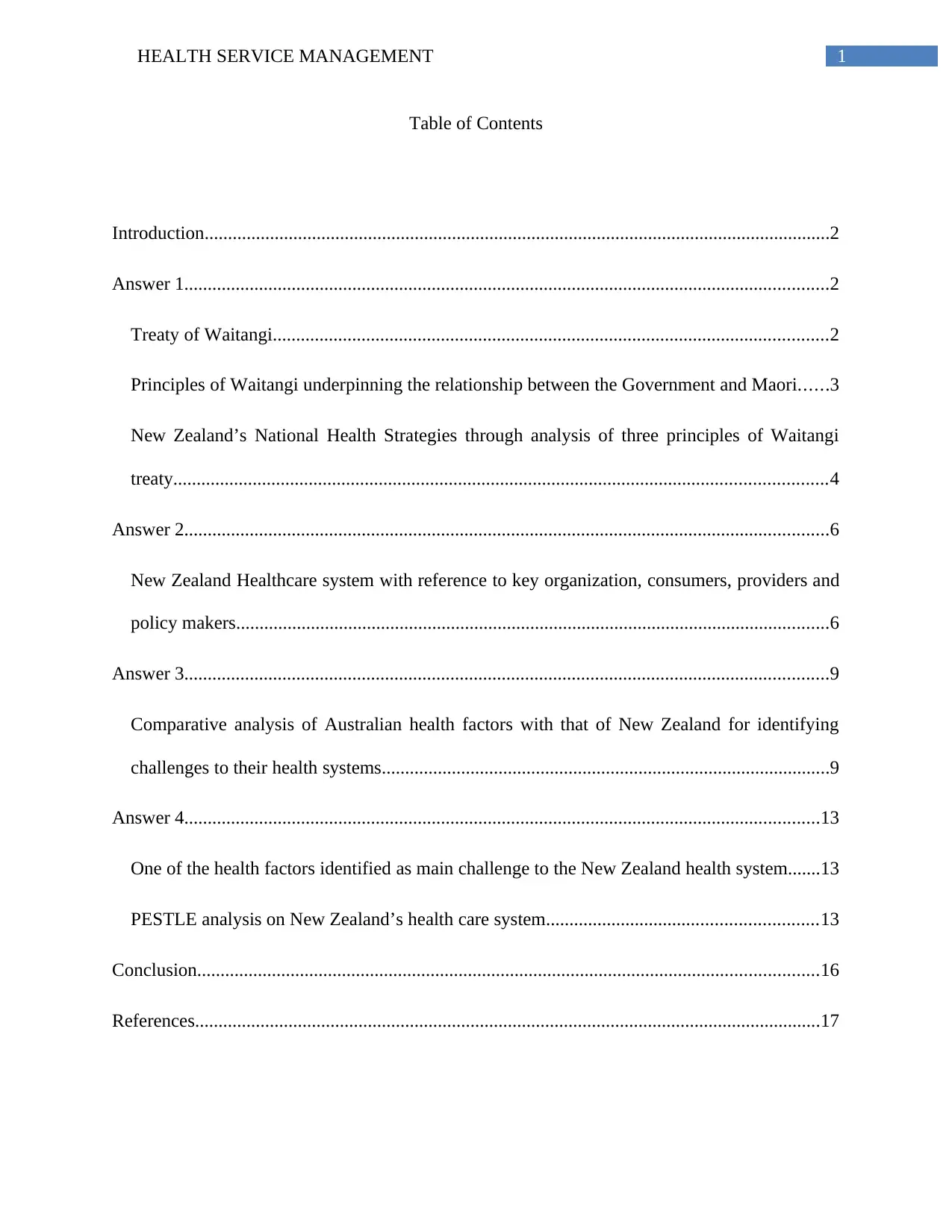
1HEALTH SERVICE MANAGEMENT
Table of Contents
Introduction......................................................................................................................................2
Answer 1..........................................................................................................................................2
Treaty of Waitangi.......................................................................................................................2
Principles of Waitangi underpinning the relationship between the Government and Maori......3
New Zealand’s National Health Strategies through analysis of three principles of Waitangi
treaty............................................................................................................................................4
Answer 2..........................................................................................................................................6
New Zealand Healthcare system with reference to key organization, consumers, providers and
policy makers...............................................................................................................................6
Answer 3..........................................................................................................................................9
Comparative analysis of Australian health factors with that of New Zealand for identifying
challenges to their health systems................................................................................................9
Answer 4........................................................................................................................................13
One of the health factors identified as main challenge to the New Zealand health system.......13
PESTLE analysis on New Zealand’s health care system..........................................................13
Conclusion.....................................................................................................................................16
References......................................................................................................................................17
Table of Contents
Introduction......................................................................................................................................2
Answer 1..........................................................................................................................................2
Treaty of Waitangi.......................................................................................................................2
Principles of Waitangi underpinning the relationship between the Government and Maori......3
New Zealand’s National Health Strategies through analysis of three principles of Waitangi
treaty............................................................................................................................................4
Answer 2..........................................................................................................................................6
New Zealand Healthcare system with reference to key organization, consumers, providers and
policy makers...............................................................................................................................6
Answer 3..........................................................................................................................................9
Comparative analysis of Australian health factors with that of New Zealand for identifying
challenges to their health systems................................................................................................9
Answer 4........................................................................................................................................13
One of the health factors identified as main challenge to the New Zealand health system.......13
PESTLE analysis on New Zealand’s health care system..........................................................13
Conclusion.....................................................................................................................................16
References......................................................................................................................................17
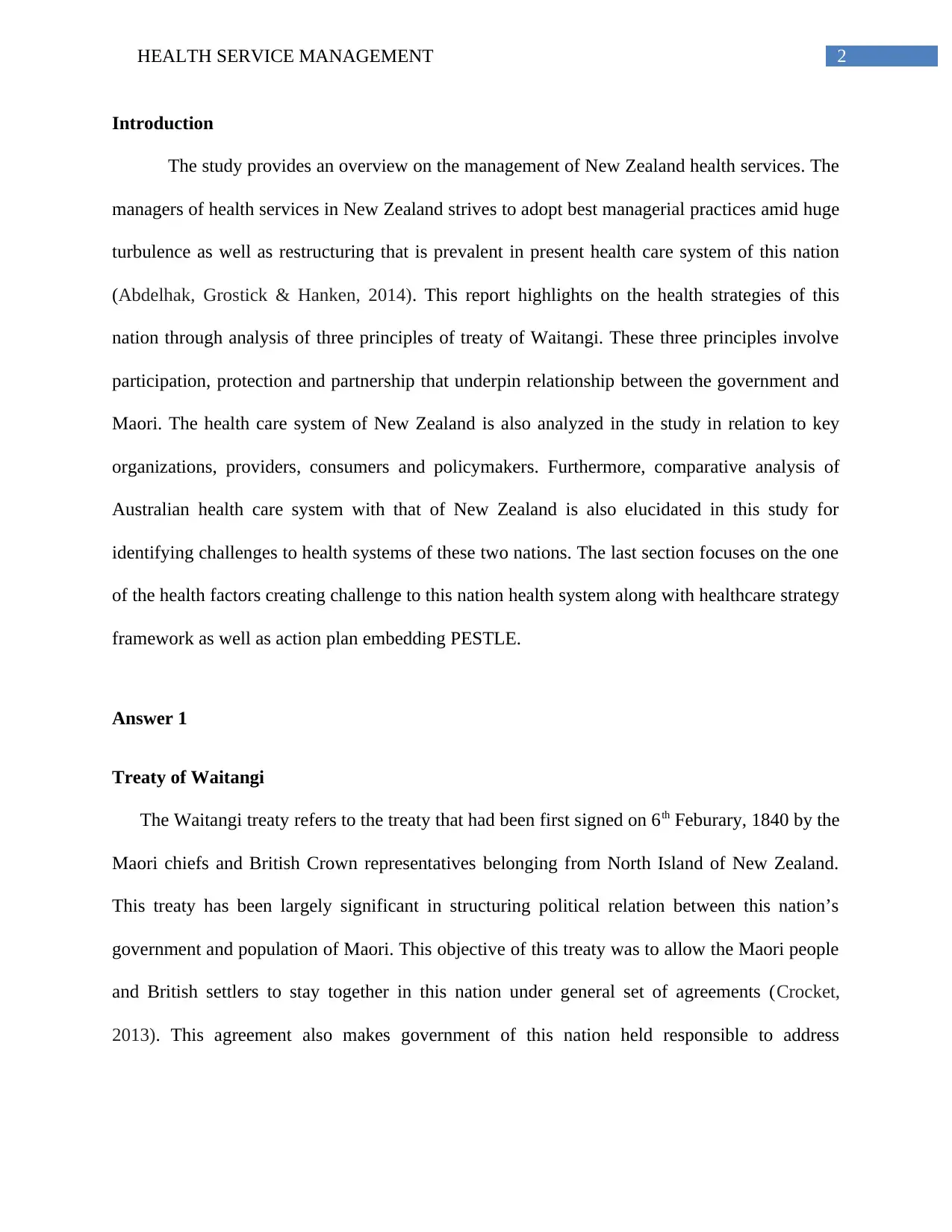
2HEALTH SERVICE MANAGEMENT
Introduction
The study provides an overview on the management of New Zealand health services. The
managers of health services in New Zealand strives to adopt best managerial practices amid huge
turbulence as well as restructuring that is prevalent in present health care system of this nation
(Abdelhak, Grostick & Hanken, 2014). This report highlights on the health strategies of this
nation through analysis of three principles of treaty of Waitangi. These three principles involve
participation, protection and partnership that underpin relationship between the government and
Maori. The health care system of New Zealand is also analyzed in the study in relation to key
organizations, providers, consumers and policymakers. Furthermore, comparative analysis of
Australian health care system with that of New Zealand is also elucidated in this study for
identifying challenges to health systems of these two nations. The last section focuses on the one
of the health factors creating challenge to this nation health system along with healthcare strategy
framework as well as action plan embedding PESTLE.
Answer 1
Treaty of Waitangi
The Waitangi treaty refers to the treaty that had been first signed on 6th Feburary, 1840 by the
Maori chiefs and British Crown representatives belonging from North Island of New Zealand.
This treaty has been largely significant in structuring political relation between this nation’s
government and population of Maori. This objective of this treaty was to allow the Maori people
and British settlers to stay together in this nation under general set of agreements (Crocket,
2013). This agreement also makes government of this nation held responsible to address
Introduction
The study provides an overview on the management of New Zealand health services. The
managers of health services in New Zealand strives to adopt best managerial practices amid huge
turbulence as well as restructuring that is prevalent in present health care system of this nation
(Abdelhak, Grostick & Hanken, 2014). This report highlights on the health strategies of this
nation through analysis of three principles of treaty of Waitangi. These three principles involve
participation, protection and partnership that underpin relationship between the government and
Maori. The health care system of New Zealand is also analyzed in the study in relation to key
organizations, providers, consumers and policymakers. Furthermore, comparative analysis of
Australian health care system with that of New Zealand is also elucidated in this study for
identifying challenges to health systems of these two nations. The last section focuses on the one
of the health factors creating challenge to this nation health system along with healthcare strategy
framework as well as action plan embedding PESTLE.
Answer 1
Treaty of Waitangi
The Waitangi treaty refers to the treaty that had been first signed on 6th Feburary, 1840 by the
Maori chiefs and British Crown representatives belonging from North Island of New Zealand.
This treaty has been largely significant in structuring political relation between this nation’s
government and population of Maori. This objective of this treaty was to allow the Maori people
and British settlers to stay together in this nation under general set of agreements (Crocket,
2013). This agreement also makes government of this nation held responsible to address
⊘ This is a preview!⊘
Do you want full access?
Subscribe today to unlock all pages.

Trusted by 1+ million students worldwide
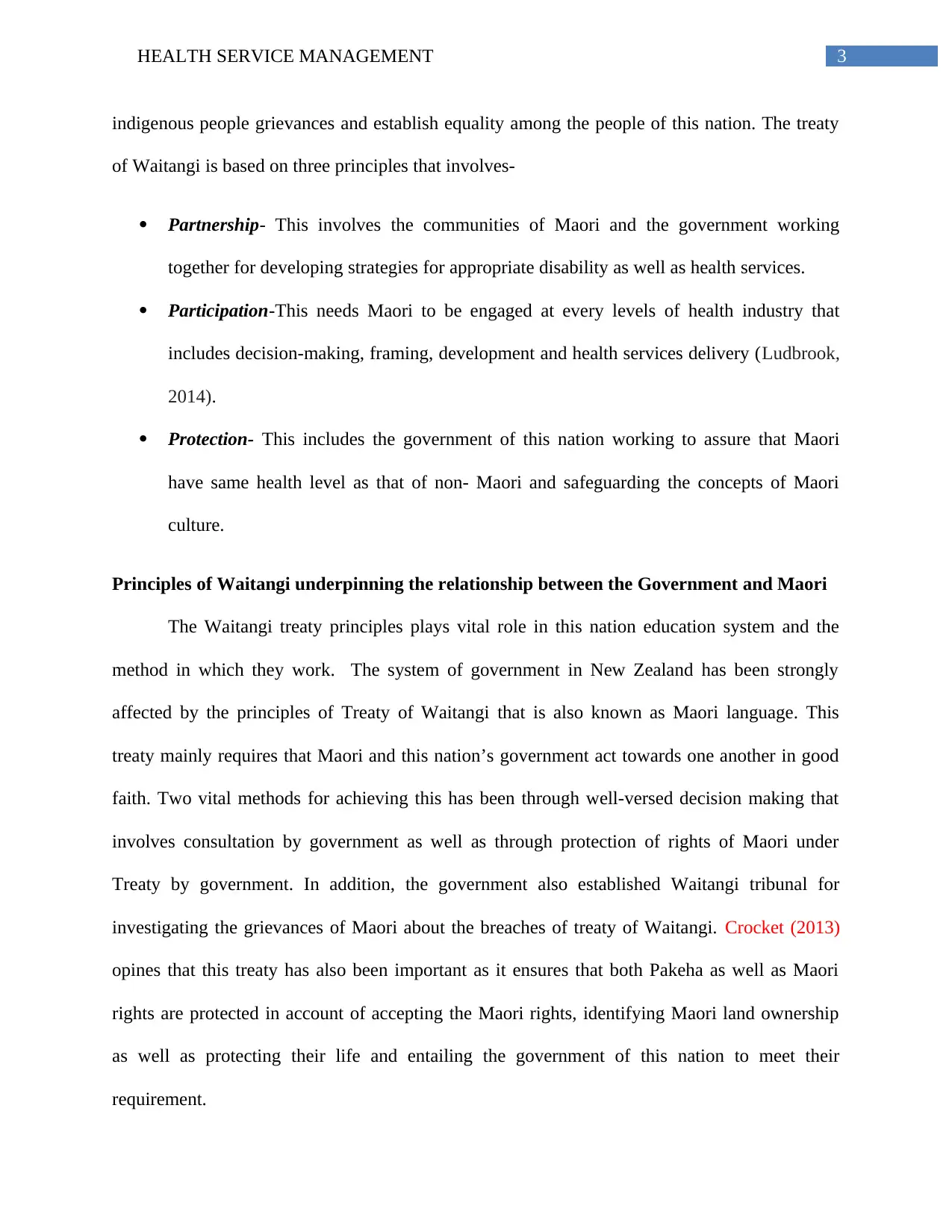
3HEALTH SERVICE MANAGEMENT
indigenous people grievances and establish equality among the people of this nation. The treaty
of Waitangi is based on three principles that involves-
Partnership- This involves the communities of Maori and the government working
together for developing strategies for appropriate disability as well as health services.
Participation-This needs Maori to be engaged at every levels of health industry that
includes decision-making, framing, development and health services delivery (Ludbrook,
2014).
Protection- This includes the government of this nation working to assure that Maori
have same health level as that of non- Maori and safeguarding the concepts of Maori
culture.
Principles of Waitangi underpinning the relationship between the Government and Maori
The Waitangi treaty principles plays vital role in this nation education system and the
method in which they work. The system of government in New Zealand has been strongly
affected by the principles of Treaty of Waitangi that is also known as Maori language. This
treaty mainly requires that Maori and this nation’s government act towards one another in good
faith. Two vital methods for achieving this has been through well-versed decision making that
involves consultation by government as well as through protection of rights of Maori under
Treaty by government. In addition, the government also established Waitangi tribunal for
investigating the grievances of Maori about the breaches of treaty of Waitangi. Crocket (2013)
opines that this treaty has also been important as it ensures that both Pakeha as well as Maori
rights are protected in account of accepting the Maori rights, identifying Maori land ownership
as well as protecting their life and entailing the government of this nation to meet their
requirement.
indigenous people grievances and establish equality among the people of this nation. The treaty
of Waitangi is based on three principles that involves-
Partnership- This involves the communities of Maori and the government working
together for developing strategies for appropriate disability as well as health services.
Participation-This needs Maori to be engaged at every levels of health industry that
includes decision-making, framing, development and health services delivery (Ludbrook,
2014).
Protection- This includes the government of this nation working to assure that Maori
have same health level as that of non- Maori and safeguarding the concepts of Maori
culture.
Principles of Waitangi underpinning the relationship between the Government and Maori
The Waitangi treaty principles plays vital role in this nation education system and the
method in which they work. The system of government in New Zealand has been strongly
affected by the principles of Treaty of Waitangi that is also known as Maori language. This
treaty mainly requires that Maori and this nation’s government act towards one another in good
faith. Two vital methods for achieving this has been through well-versed decision making that
involves consultation by government as well as through protection of rights of Maori under
Treaty by government. In addition, the government also established Waitangi tribunal for
investigating the grievances of Maori about the breaches of treaty of Waitangi. Crocket (2013)
opines that this treaty has also been important as it ensures that both Pakeha as well as Maori
rights are protected in account of accepting the Maori rights, identifying Maori land ownership
as well as protecting their life and entailing the government of this nation to meet their
requirement.
Paraphrase This Document
Need a fresh take? Get an instant paraphrase of this document with our AI Paraphraser
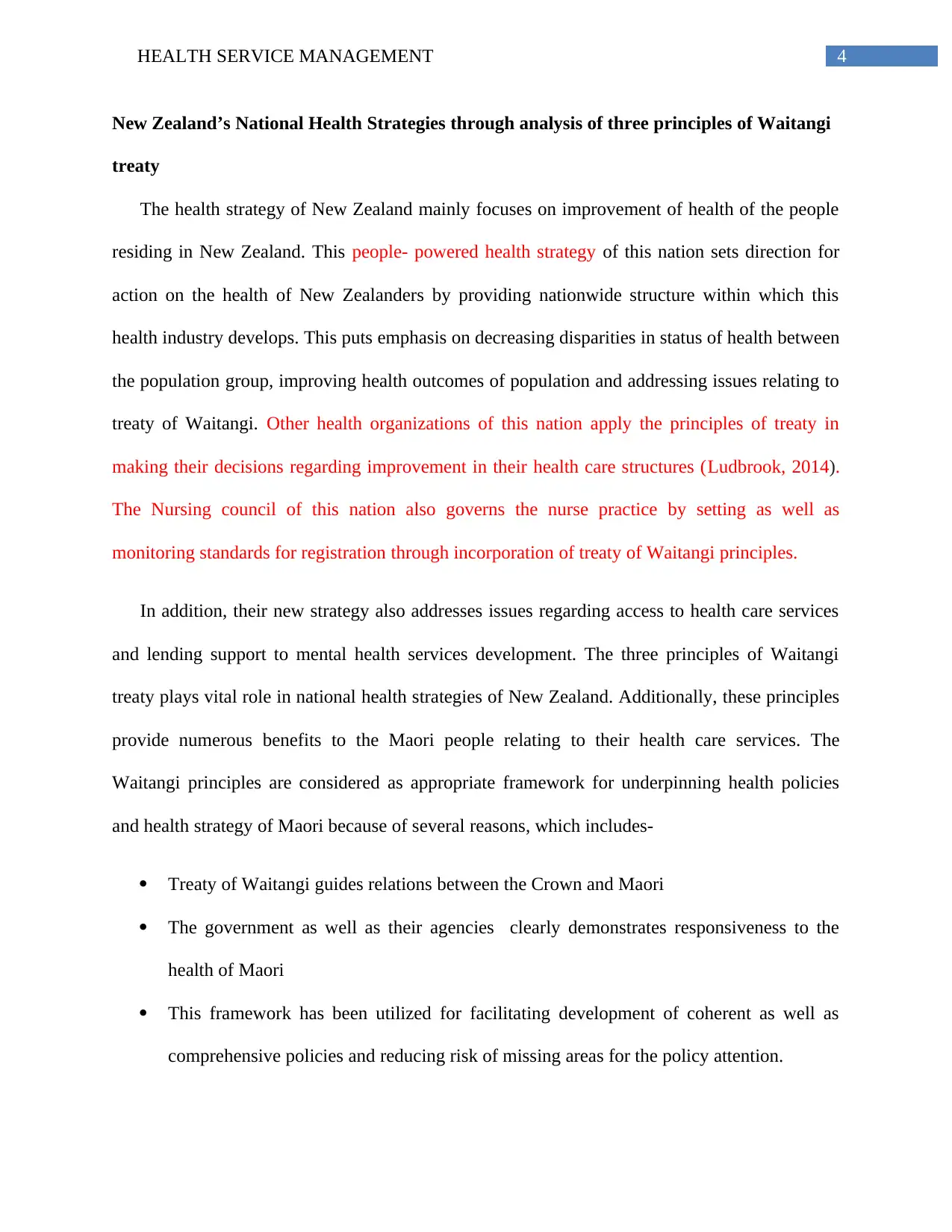
4HEALTH SERVICE MANAGEMENT
New Zealand’s National Health Strategies through analysis of three principles of Waitangi
treaty
The health strategy of New Zealand mainly focuses on improvement of health of the people
residing in New Zealand. This people- powered health strategy of this nation sets direction for
action on the health of New Zealanders by providing nationwide structure within which this
health industry develops. This puts emphasis on decreasing disparities in status of health between
the population group, improving health outcomes of population and addressing issues relating to
treaty of Waitangi. Other health organizations of this nation apply the principles of treaty in
making their decisions regarding improvement in their health care structures (Ludbrook, 2014).
The Nursing council of this nation also governs the nurse practice by setting as well as
monitoring standards for registration through incorporation of treaty of Waitangi principles.
In addition, their new strategy also addresses issues regarding access to health care services
and lending support to mental health services development. The three principles of Waitangi
treaty plays vital role in national health strategies of New Zealand. Additionally, these principles
provide numerous benefits to the Maori people relating to their health care services. The
Waitangi principles are considered as appropriate framework for underpinning health policies
and health strategy of Maori because of several reasons, which includes-
Treaty of Waitangi guides relations between the Crown and Maori
The government as well as their agencies clearly demonstrates responsiveness to the
health of Maori
This framework has been utilized for facilitating development of coherent as well as
comprehensive policies and reducing risk of missing areas for the policy attention.
New Zealand’s National Health Strategies through analysis of three principles of Waitangi
treaty
The health strategy of New Zealand mainly focuses on improvement of health of the people
residing in New Zealand. This people- powered health strategy of this nation sets direction for
action on the health of New Zealanders by providing nationwide structure within which this
health industry develops. This puts emphasis on decreasing disparities in status of health between
the population group, improving health outcomes of population and addressing issues relating to
treaty of Waitangi. Other health organizations of this nation apply the principles of treaty in
making their decisions regarding improvement in their health care structures (Ludbrook, 2014).
The Nursing council of this nation also governs the nurse practice by setting as well as
monitoring standards for registration through incorporation of treaty of Waitangi principles.
In addition, their new strategy also addresses issues regarding access to health care services
and lending support to mental health services development. The three principles of Waitangi
treaty plays vital role in national health strategies of New Zealand. Additionally, these principles
provide numerous benefits to the Maori people relating to their health care services. The
Waitangi principles are considered as appropriate framework for underpinning health policies
and health strategy of Maori because of several reasons, which includes-
Treaty of Waitangi guides relations between the Crown and Maori
The government as well as their agencies clearly demonstrates responsiveness to the
health of Maori
This framework has been utilized for facilitating development of coherent as well as
comprehensive policies and reducing risk of missing areas for the policy attention.
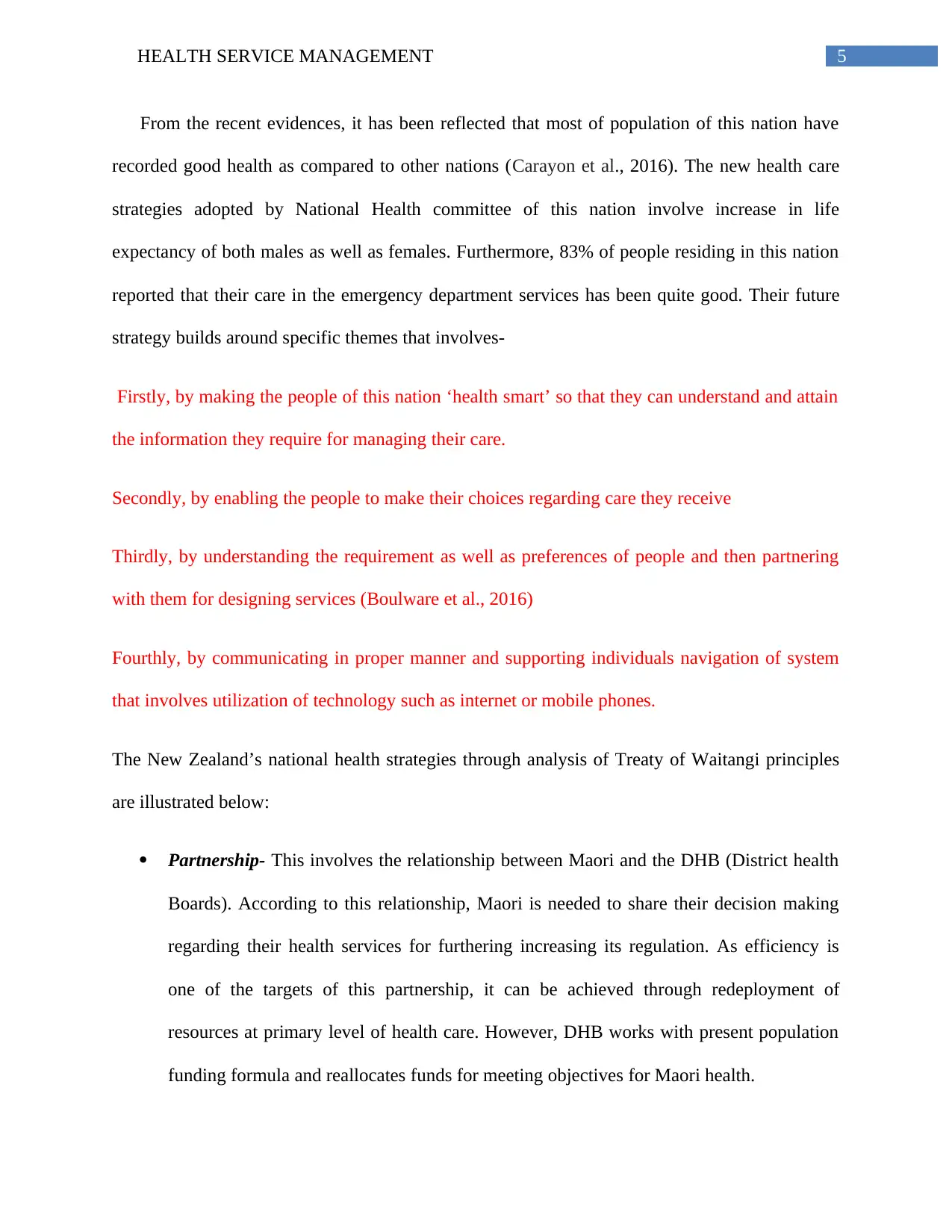
5HEALTH SERVICE MANAGEMENT
From the recent evidences, it has been reflected that most of population of this nation have
recorded good health as compared to other nations (Carayon et al., 2016). The new health care
strategies adopted by National Health committee of this nation involve increase in life
expectancy of both males as well as females. Furthermore, 83% of people residing in this nation
reported that their care in the emergency department services has been quite good. Their future
strategy builds around specific themes that involves-
Firstly, by making the people of this nation ‘health smart’ so that they can understand and attain
the information they require for managing their care.
Secondly, by enabling the people to make their choices regarding care they receive
Thirdly, by understanding the requirement as well as preferences of people and then partnering
with them for designing services (Boulware et al., 2016)
Fourthly, by communicating in proper manner and supporting individuals navigation of system
that involves utilization of technology such as internet or mobile phones.
The New Zealand’s national health strategies through analysis of Treaty of Waitangi principles
are illustrated below:
Partnership- This involves the relationship between Maori and the DHB (District health
Boards). According to this relationship, Maori is needed to share their decision making
regarding their health services for furthering increasing its regulation. As efficiency is
one of the targets of this partnership, it can be achieved through redeployment of
resources at primary level of health care. However, DHB works with present population
funding formula and reallocates funds for meeting objectives for Maori health.
From the recent evidences, it has been reflected that most of population of this nation have
recorded good health as compared to other nations (Carayon et al., 2016). The new health care
strategies adopted by National Health committee of this nation involve increase in life
expectancy of both males as well as females. Furthermore, 83% of people residing in this nation
reported that their care in the emergency department services has been quite good. Their future
strategy builds around specific themes that involves-
Firstly, by making the people of this nation ‘health smart’ so that they can understand and attain
the information they require for managing their care.
Secondly, by enabling the people to make their choices regarding care they receive
Thirdly, by understanding the requirement as well as preferences of people and then partnering
with them for designing services (Boulware et al., 2016)
Fourthly, by communicating in proper manner and supporting individuals navigation of system
that involves utilization of technology such as internet or mobile phones.
The New Zealand’s national health strategies through analysis of Treaty of Waitangi principles
are illustrated below:
Partnership- This involves the relationship between Maori and the DHB (District health
Boards). According to this relationship, Maori is needed to share their decision making
regarding their health services for furthering increasing its regulation. As efficiency is
one of the targets of this partnership, it can be achieved through redeployment of
resources at primary level of health care. However, DHB works with present population
funding formula and reallocates funds for meeting objectives for Maori health.
⊘ This is a preview!⊘
Do you want full access?
Subscribe today to unlock all pages.

Trusted by 1+ million students worldwide
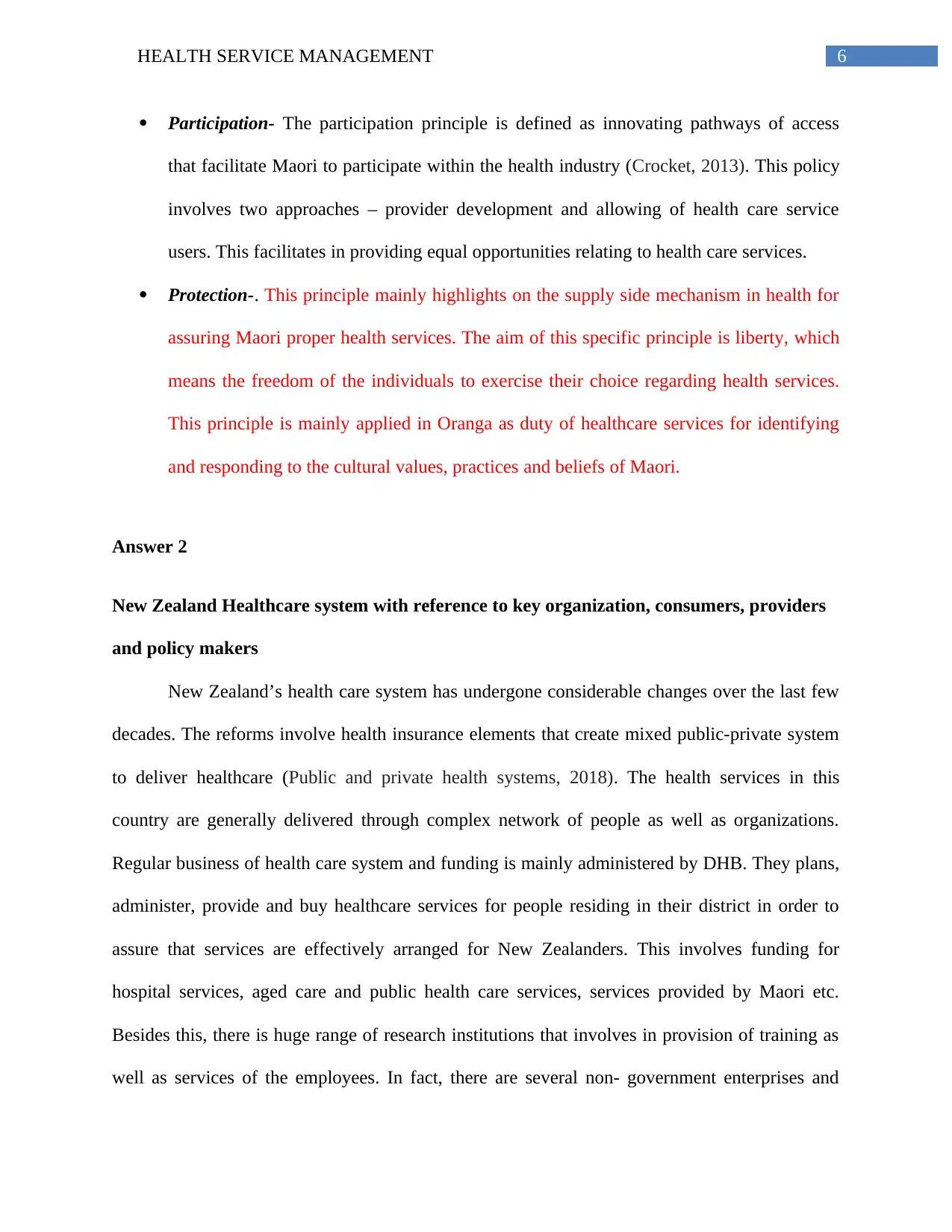
6HEALTH SERVICE MANAGEMENT
Participation- The participation principle is defined as innovating pathways of access
that facilitate Maori to participate within the health industry (Crocket, 2013). This policy
involves two approaches – provider development and allowing of health care service
users. This facilitates in providing equal opportunities relating to health care services.
Protection-. This principle mainly highlights on the supply side mechanism in health for
assuring Maori proper health services. The aim of this specific principle is liberty, which
means the freedom of the individuals to exercise their choice regarding health services.
This principle is mainly applied in Oranga as duty of healthcare services for identifying
and responding to the cultural values, practices and beliefs of Maori.
Answer 2
New Zealand Healthcare system with reference to key organization, consumers, providers
and policy makers
New Zealand’s health care system has undergone considerable changes over the last few
decades. The reforms involve health insurance elements that create mixed public-private system
to deliver healthcare (Public and private health systems, 2018). The health services in this
country are generally delivered through complex network of people as well as organizations.
Regular business of health care system and funding is mainly administered by DHB. They plans,
administer, provide and buy healthcare services for people residing in their district in order to
assure that services are effectively arranged for New Zealanders. This involves funding for
hospital services, aged care and public health care services, services provided by Maori etc.
Besides this, there is huge range of research institutions that involves in provision of training as
well as services of the employees. In fact, there are several non- government enterprises and
Participation- The participation principle is defined as innovating pathways of access
that facilitate Maori to participate within the health industry (Crocket, 2013). This policy
involves two approaches – provider development and allowing of health care service
users. This facilitates in providing equal opportunities relating to health care services.
Protection-. This principle mainly highlights on the supply side mechanism in health for
assuring Maori proper health services. The aim of this specific principle is liberty, which
means the freedom of the individuals to exercise their choice regarding health services.
This principle is mainly applied in Oranga as duty of healthcare services for identifying
and responding to the cultural values, practices and beliefs of Maori.
Answer 2
New Zealand Healthcare system with reference to key organization, consumers, providers
and policy makers
New Zealand’s health care system has undergone considerable changes over the last few
decades. The reforms involve health insurance elements that create mixed public-private system
to deliver healthcare (Public and private health systems, 2018). The health services in this
country are generally delivered through complex network of people as well as organizations.
Regular business of health care system and funding is mainly administered by DHB. They plans,
administer, provide and buy healthcare services for people residing in their district in order to
assure that services are effectively arranged for New Zealanders. This involves funding for
hospital services, aged care and public health care services, services provided by Maori etc.
Besides this, there is huge range of research institutions that involves in provision of training as
well as services of the employees. In fact, there are several non- government enterprises and
Paraphrase This Document
Need a fresh take? Get an instant paraphrase of this document with our AI Paraphraser
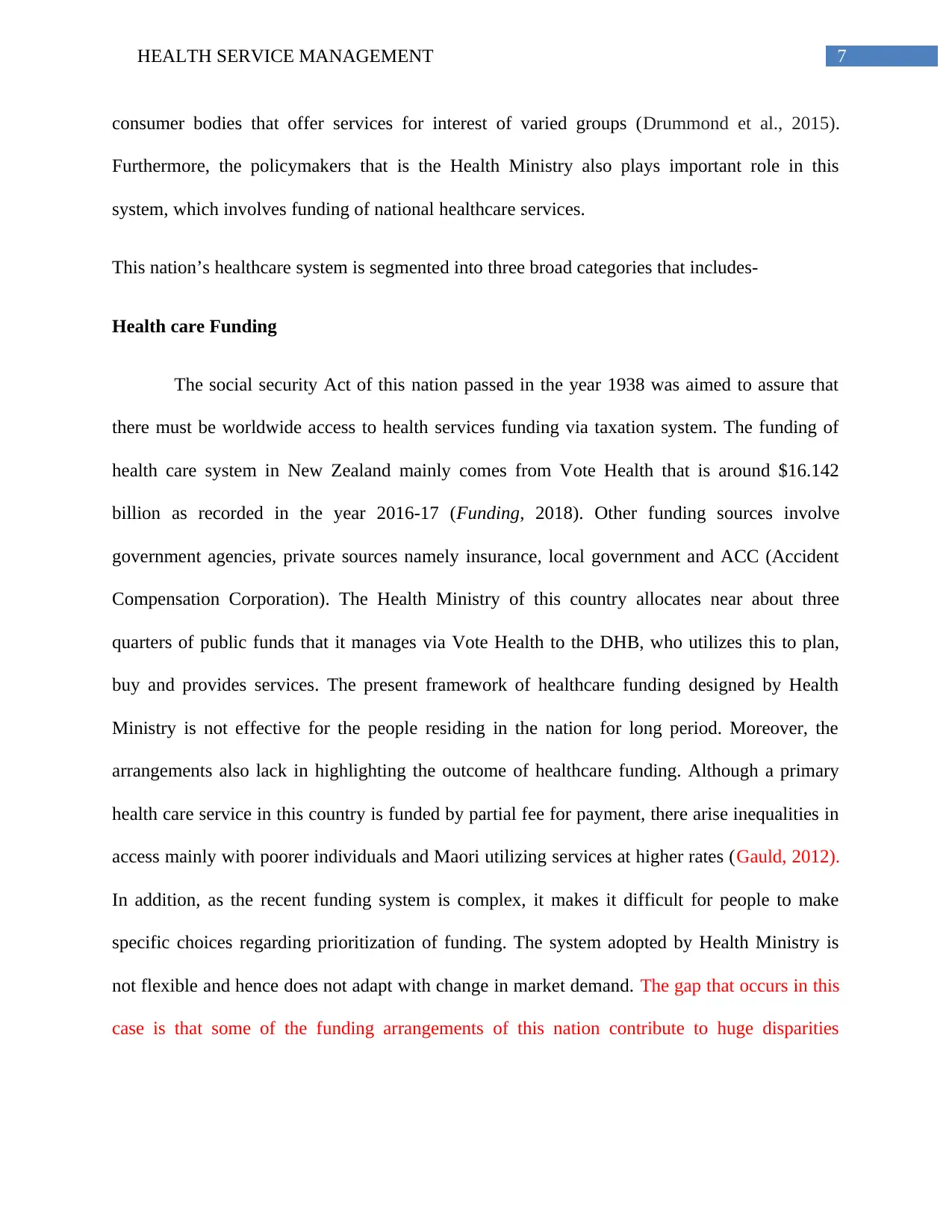
7HEALTH SERVICE MANAGEMENT
consumer bodies that offer services for interest of varied groups (Drummond et al., 2015).
Furthermore, the policymakers that is the Health Ministry also plays important role in this
system, which involves funding of national healthcare services.
This nation’s healthcare system is segmented into three broad categories that includes-
Health care Funding
The social security Act of this nation passed in the year 1938 was aimed to assure that
there must be worldwide access to health services funding via taxation system. The funding of
health care system in New Zealand mainly comes from Vote Health that is around $16.142
billion as recorded in the year 2016-17 (Funding, 2018). Other funding sources involve
government agencies, private sources namely insurance, local government and ACC (Accident
Compensation Corporation). The Health Ministry of this country allocates near about three
quarters of public funds that it manages via Vote Health to the DHB, who utilizes this to plan,
buy and provides services. The present framework of healthcare funding designed by Health
Ministry is not effective for the people residing in the nation for long period. Moreover, the
arrangements also lack in highlighting the outcome of healthcare funding. Although a primary
health care service in this country is funded by partial fee for payment, there arise inequalities in
access mainly with poorer individuals and Maori utilizing services at higher rates (Gauld, 2012).
In addition, as the recent funding system is complex, it makes it difficult for people to make
specific choices regarding prioritization of funding. The system adopted by Health Ministry is
not flexible and hence does not adapt with change in market demand. The gap that occurs in this
case is that some of the funding arrangements of this nation contribute to huge disparities
consumer bodies that offer services for interest of varied groups (Drummond et al., 2015).
Furthermore, the policymakers that is the Health Ministry also plays important role in this
system, which involves funding of national healthcare services.
This nation’s healthcare system is segmented into three broad categories that includes-
Health care Funding
The social security Act of this nation passed in the year 1938 was aimed to assure that
there must be worldwide access to health services funding via taxation system. The funding of
health care system in New Zealand mainly comes from Vote Health that is around $16.142
billion as recorded in the year 2016-17 (Funding, 2018). Other funding sources involve
government agencies, private sources namely insurance, local government and ACC (Accident
Compensation Corporation). The Health Ministry of this country allocates near about three
quarters of public funds that it manages via Vote Health to the DHB, who utilizes this to plan,
buy and provides services. The present framework of healthcare funding designed by Health
Ministry is not effective for the people residing in the nation for long period. Moreover, the
arrangements also lack in highlighting the outcome of healthcare funding. Although a primary
health care service in this country is funded by partial fee for payment, there arise inequalities in
access mainly with poorer individuals and Maori utilizing services at higher rates (Gauld, 2012).
In addition, as the recent funding system is complex, it makes it difficult for people to make
specific choices regarding prioritization of funding. The system adopted by Health Ministry is
not flexible and hence does not adapt with change in market demand. The gap that occurs in this
case is that some of the funding arrangements of this nation contribute to huge disparities
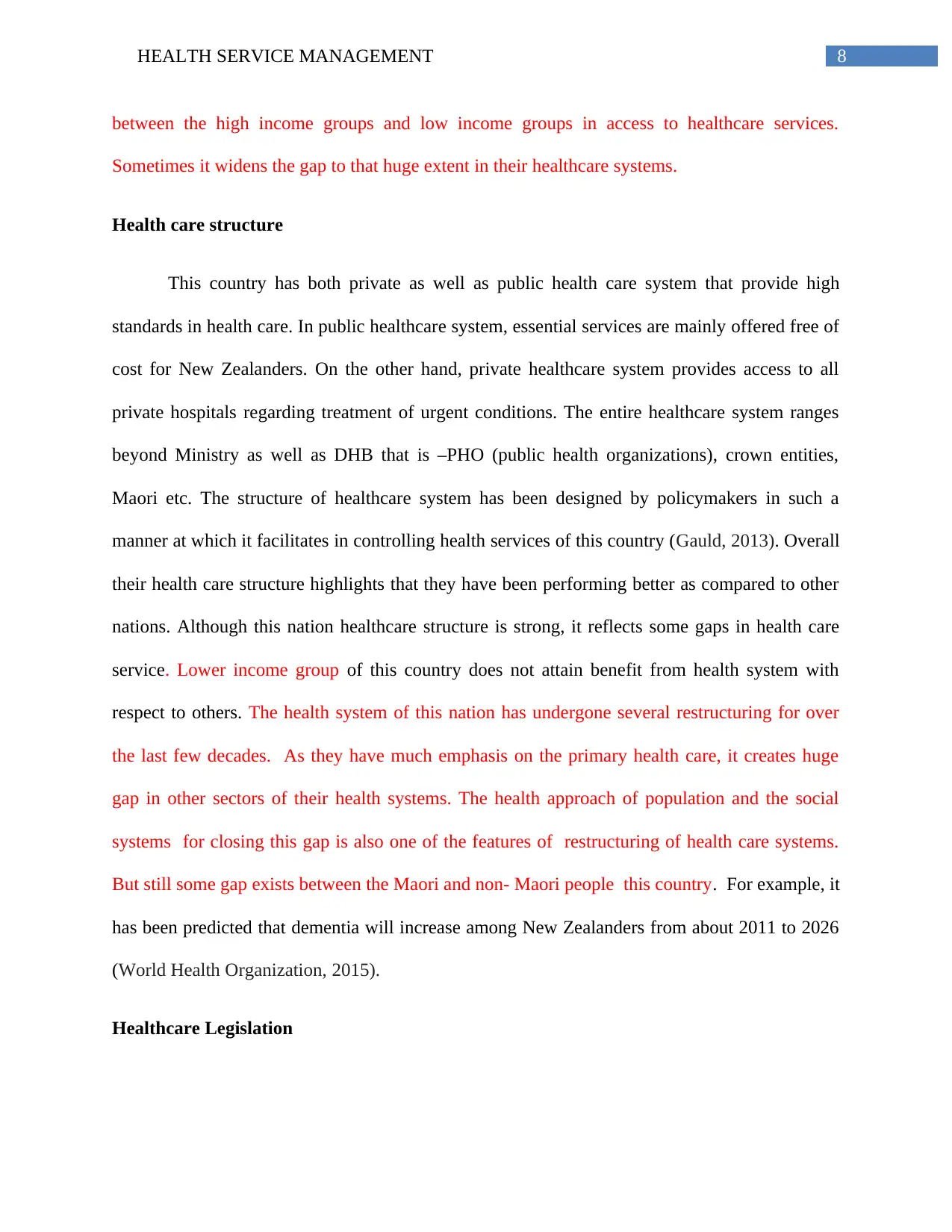
8HEALTH SERVICE MANAGEMENT
between the high income groups and low income groups in access to healthcare services.
Sometimes it widens the gap to that huge extent in their healthcare systems.
Health care structure
This country has both private as well as public health care system that provide high
standards in health care. In public healthcare system, essential services are mainly offered free of
cost for New Zealanders. On the other hand, private healthcare system provides access to all
private hospitals regarding treatment of urgent conditions. The entire healthcare system ranges
beyond Ministry as well as DHB that is –PHO (public health organizations), crown entities,
Maori etc. The structure of healthcare system has been designed by policymakers in such a
manner at which it facilitates in controlling health services of this country (Gauld, 2013). Overall
their health care structure highlights that they have been performing better as compared to other
nations. Although this nation healthcare structure is strong, it reflects some gaps in health care
service. Lower income group of this country does not attain benefit from health system with
respect to others. The health system of this nation has undergone several restructuring for over
the last few decades. As they have much emphasis on the primary health care, it creates huge
gap in other sectors of their health systems. The health approach of population and the social
systems for closing this gap is also one of the features of restructuring of health care systems.
But still some gap exists between the Maori and non- Maori people this country. For example, it
has been predicted that dementia will increase among New Zealanders from about 2011 to 2026
(World Health Organization, 2015).
Healthcare Legislation
between the high income groups and low income groups in access to healthcare services.
Sometimes it widens the gap to that huge extent in their healthcare systems.
Health care structure
This country has both private as well as public health care system that provide high
standards in health care. In public healthcare system, essential services are mainly offered free of
cost for New Zealanders. On the other hand, private healthcare system provides access to all
private hospitals regarding treatment of urgent conditions. The entire healthcare system ranges
beyond Ministry as well as DHB that is –PHO (public health organizations), crown entities,
Maori etc. The structure of healthcare system has been designed by policymakers in such a
manner at which it facilitates in controlling health services of this country (Gauld, 2013). Overall
their health care structure highlights that they have been performing better as compared to other
nations. Although this nation healthcare structure is strong, it reflects some gaps in health care
service. Lower income group of this country does not attain benefit from health system with
respect to others. The health system of this nation has undergone several restructuring for over
the last few decades. As they have much emphasis on the primary health care, it creates huge
gap in other sectors of their health systems. The health approach of population and the social
systems for closing this gap is also one of the features of restructuring of health care systems.
But still some gap exists between the Maori and non- Maori people this country. For example, it
has been predicted that dementia will increase among New Zealanders from about 2011 to 2026
(World Health Organization, 2015).
Healthcare Legislation
⊘ This is a preview!⊘
Do you want full access?
Subscribe today to unlock all pages.

Trusted by 1+ million students worldwide
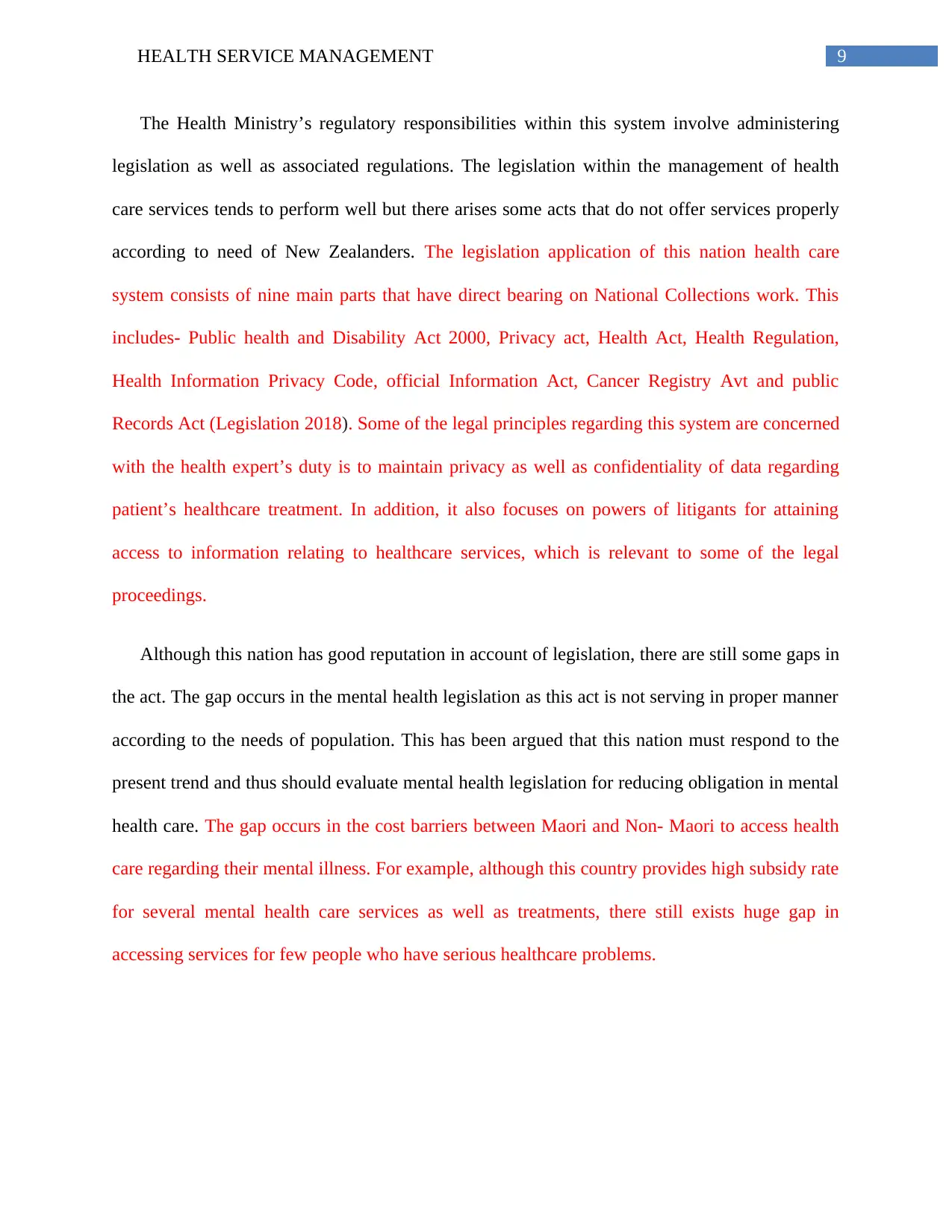
9HEALTH SERVICE MANAGEMENT
The Health Ministry’s regulatory responsibilities within this system involve administering
legislation as well as associated regulations. The legislation within the management of health
care services tends to perform well but there arises some acts that do not offer services properly
according to need of New Zealanders. The legislation application of this nation health care
system consists of nine main parts that have direct bearing on National Collections work. This
includes- Public health and Disability Act 2000, Privacy act, Health Act, Health Regulation,
Health Information Privacy Code, official Information Act, Cancer Registry Avt and public
Records Act (Legislation 2018). Some of the legal principles regarding this system are concerned
with the health expert’s duty is to maintain privacy as well as confidentiality of data regarding
patient’s healthcare treatment. In addition, it also focuses on powers of litigants for attaining
access to information relating to healthcare services, which is relevant to some of the legal
proceedings.
Although this nation has good reputation in account of legislation, there are still some gaps in
the act. The gap occurs in the mental health legislation as this act is not serving in proper manner
according to the needs of population. This has been argued that this nation must respond to the
present trend and thus should evaluate mental health legislation for reducing obligation in mental
health care. The gap occurs in the cost barriers between Maori and Non- Maori to access health
care regarding their mental illness. For example, although this country provides high subsidy rate
for several mental health care services as well as treatments, there still exists huge gap in
accessing services for few people who have serious healthcare problems.
The Health Ministry’s regulatory responsibilities within this system involve administering
legislation as well as associated regulations. The legislation within the management of health
care services tends to perform well but there arises some acts that do not offer services properly
according to need of New Zealanders. The legislation application of this nation health care
system consists of nine main parts that have direct bearing on National Collections work. This
includes- Public health and Disability Act 2000, Privacy act, Health Act, Health Regulation,
Health Information Privacy Code, official Information Act, Cancer Registry Avt and public
Records Act (Legislation 2018). Some of the legal principles regarding this system are concerned
with the health expert’s duty is to maintain privacy as well as confidentiality of data regarding
patient’s healthcare treatment. In addition, it also focuses on powers of litigants for attaining
access to information relating to healthcare services, which is relevant to some of the legal
proceedings.
Although this nation has good reputation in account of legislation, there are still some gaps in
the act. The gap occurs in the mental health legislation as this act is not serving in proper manner
according to the needs of population. This has been argued that this nation must respond to the
present trend and thus should evaluate mental health legislation for reducing obligation in mental
health care. The gap occurs in the cost barriers between Maori and Non- Maori to access health
care regarding their mental illness. For example, although this country provides high subsidy rate
for several mental health care services as well as treatments, there still exists huge gap in
accessing services for few people who have serious healthcare problems.
Paraphrase This Document
Need a fresh take? Get an instant paraphrase of this document with our AI Paraphraser
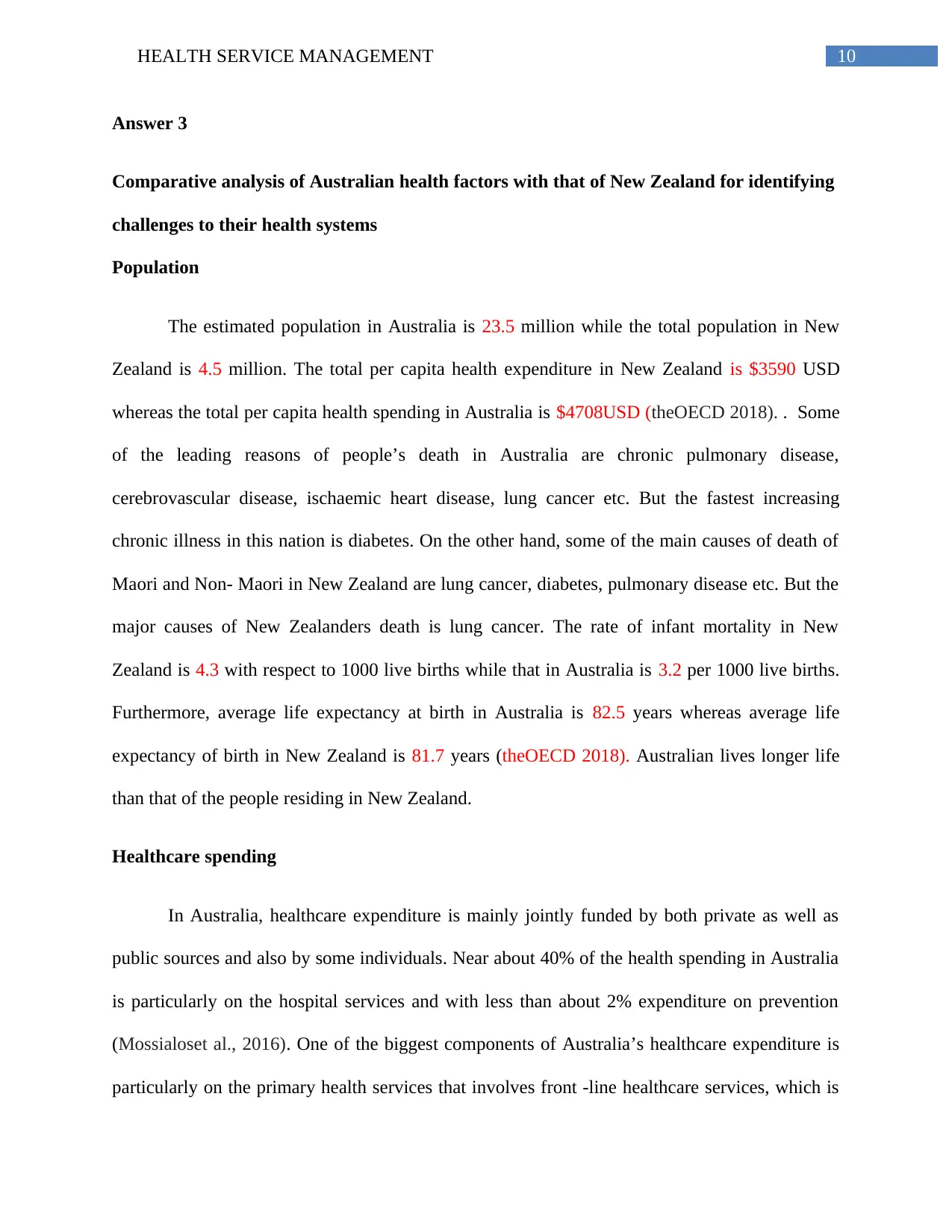
10HEALTH SERVICE MANAGEMENT
Answer 3
Comparative analysis of Australian health factors with that of New Zealand for identifying
challenges to their health systems
Population
The estimated population in Australia is 23.5 million while the total population in New
Zealand is 4.5 million. The total per capita health expenditure in New Zealand is $3590 USD
whereas the total per capita health spending in Australia is $4708USD (theOECD 2018). . Some
of the leading reasons of people’s death in Australia are chronic pulmonary disease,
cerebrovascular disease, ischaemic heart disease, lung cancer etc. But the fastest increasing
chronic illness in this nation is diabetes. On the other hand, some of the main causes of death of
Maori and Non- Maori in New Zealand are lung cancer, diabetes, pulmonary disease etc. But the
major causes of New Zealanders death is lung cancer. The rate of infant mortality in New
Zealand is 4.3 with respect to 1000 live births while that in Australia is 3.2 per 1000 live births.
Furthermore, average life expectancy at birth in Australia is 82.5 years whereas average life
expectancy of birth in New Zealand is 81.7 years (theOECD 2018). Australian lives longer life
than that of the people residing in New Zealand.
Healthcare spending
In Australia, healthcare expenditure is mainly jointly funded by both private as well as
public sources and also by some individuals. Near about 40% of the health spending in Australia
is particularly on the hospital services and with less than about 2% expenditure on prevention
(Mossialoset al., 2016). One of the biggest components of Australia’s healthcare expenditure is
particularly on the primary health services that involves front -line healthcare services, which is
Answer 3
Comparative analysis of Australian health factors with that of New Zealand for identifying
challenges to their health systems
Population
The estimated population in Australia is 23.5 million while the total population in New
Zealand is 4.5 million. The total per capita health expenditure in New Zealand is $3590 USD
whereas the total per capita health spending in Australia is $4708USD (theOECD 2018). . Some
of the leading reasons of people’s death in Australia are chronic pulmonary disease,
cerebrovascular disease, ischaemic heart disease, lung cancer etc. But the fastest increasing
chronic illness in this nation is diabetes. On the other hand, some of the main causes of death of
Maori and Non- Maori in New Zealand are lung cancer, diabetes, pulmonary disease etc. But the
major causes of New Zealanders death is lung cancer. The rate of infant mortality in New
Zealand is 4.3 with respect to 1000 live births while that in Australia is 3.2 per 1000 live births.
Furthermore, average life expectancy at birth in Australia is 82.5 years whereas average life
expectancy of birth in New Zealand is 81.7 years (theOECD 2018). Australian lives longer life
than that of the people residing in New Zealand.
Healthcare spending
In Australia, healthcare expenditure is mainly jointly funded by both private as well as
public sources and also by some individuals. Near about 40% of the health spending in Australia
is particularly on the hospital services and with less than about 2% expenditure on prevention
(Mossialoset al., 2016). One of the biggest components of Australia’s healthcare expenditure is
particularly on the primary health services that involves front -line healthcare services, which is
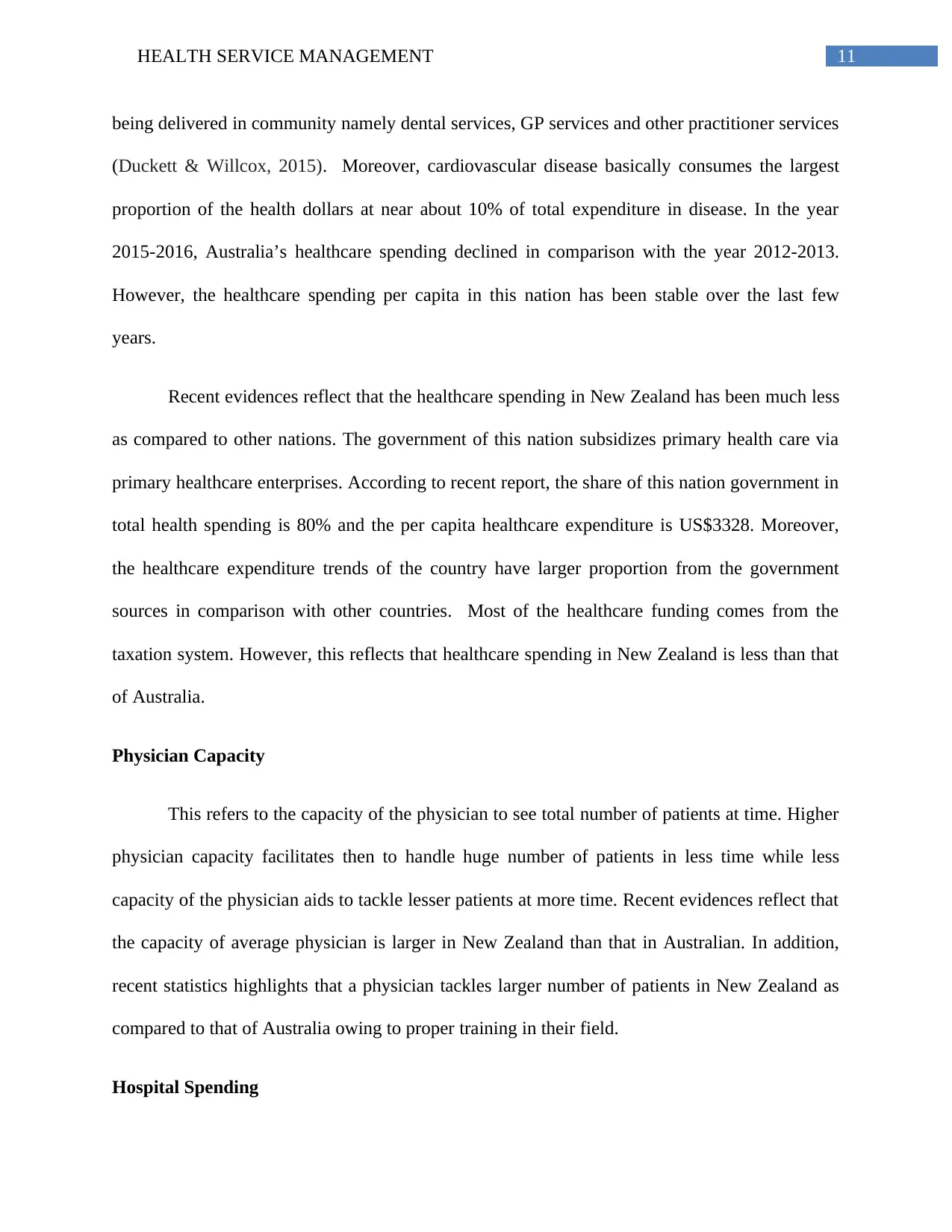
11HEALTH SERVICE MANAGEMENT
being delivered in community namely dental services, GP services and other practitioner services
(Duckett & Willcox, 2015). Moreover, cardiovascular disease basically consumes the largest
proportion of the health dollars at near about 10% of total expenditure in disease. In the year
2015-2016, Australia’s healthcare spending declined in comparison with the year 2012-2013.
However, the healthcare spending per capita in this nation has been stable over the last few
years.
Recent evidences reflect that the healthcare spending in New Zealand has been much less
as compared to other nations. The government of this nation subsidizes primary health care via
primary healthcare enterprises. According to recent report, the share of this nation government in
total health spending is 80% and the per capita healthcare expenditure is US$3328. Moreover,
the healthcare expenditure trends of the country have larger proportion from the government
sources in comparison with other countries. Most of the healthcare funding comes from the
taxation system. However, this reflects that healthcare spending in New Zealand is less than that
of Australia.
Physician Capacity
This refers to the capacity of the physician to see total number of patients at time. Higher
physician capacity facilitates then to handle huge number of patients in less time while less
capacity of the physician aids to tackle lesser patients at more time. Recent evidences reflect that
the capacity of average physician is larger in New Zealand than that in Australian. In addition,
recent statistics highlights that a physician tackles larger number of patients in New Zealand as
compared to that of Australia owing to proper training in their field.
Hospital Spending
being delivered in community namely dental services, GP services and other practitioner services
(Duckett & Willcox, 2015). Moreover, cardiovascular disease basically consumes the largest
proportion of the health dollars at near about 10% of total expenditure in disease. In the year
2015-2016, Australia’s healthcare spending declined in comparison with the year 2012-2013.
However, the healthcare spending per capita in this nation has been stable over the last few
years.
Recent evidences reflect that the healthcare spending in New Zealand has been much less
as compared to other nations. The government of this nation subsidizes primary health care via
primary healthcare enterprises. According to recent report, the share of this nation government in
total health spending is 80% and the per capita healthcare expenditure is US$3328. Moreover,
the healthcare expenditure trends of the country have larger proportion from the government
sources in comparison with other countries. Most of the healthcare funding comes from the
taxation system. However, this reflects that healthcare spending in New Zealand is less than that
of Australia.
Physician Capacity
This refers to the capacity of the physician to see total number of patients at time. Higher
physician capacity facilitates then to handle huge number of patients in less time while less
capacity of the physician aids to tackle lesser patients at more time. Recent evidences reflect that
the capacity of average physician is larger in New Zealand than that in Australian. In addition,
recent statistics highlights that a physician tackles larger number of patients in New Zealand as
compared to that of Australia owing to proper training in their field.
Hospital Spending
⊘ This is a preview!⊘
Do you want full access?
Subscribe today to unlock all pages.

Trusted by 1+ million students worldwide
1 out of 22
Related Documents
Your All-in-One AI-Powered Toolkit for Academic Success.
+13062052269
info@desklib.com
Available 24*7 on WhatsApp / Email
![[object Object]](/_next/static/media/star-bottom.7253800d.svg)
Unlock your academic potential
Copyright © 2020–2025 A2Z Services. All Rights Reserved. Developed and managed by ZUCOL.





